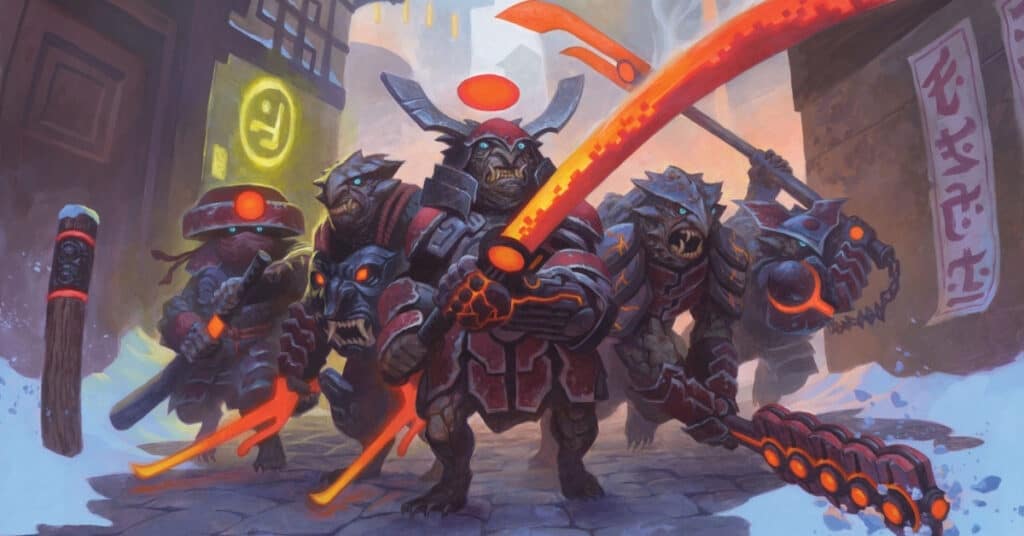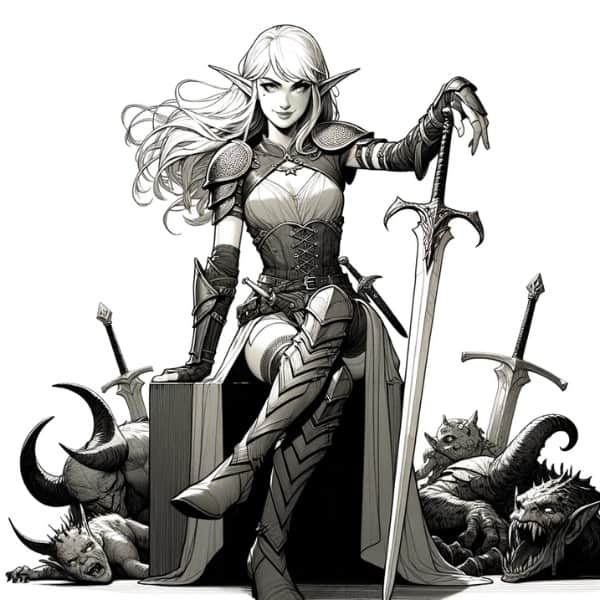Last Updated on October 31, 2023
I’ve found myself getting a little frustrated with how long combat takes in D&D 5e, especially with larger groups.
So, with that reason in mind, let’s talk about ways to fix the thing I really don’t like about combat in D&D 5e: how freaking slow can be.
5 Ideas To Speed up Combat in D&D 5e
I want to share a few things I’ve done that have worked for me to differing degrees.
Some of them contradict each other, and some are more drastic than others, which is why I’ve graded my ideas by severity, from minor tweaks to serious, fundamental game-altering stuff.
Let’s start small, shall we?
1. Morale Rules – When to Run Away
D&D feels the most real when the monsters both want to win and want to live.
Morale is an optional rule in D&D that tries to take into account when a creature would try to run away. Either just general fear or trying to avoid death.
The morale rules can be found on page 273 of the Dungeon Master’s Guide.
“To determine whether a creature or group of creatures flees, make a DC 10 Wisdom saving throw for the creature or the group’s leader […] On a failed save, the affected creature or group flees by the most expeditious route.”
If the players are handily winning a fight, successfully take out the other side’s leader, confront a creature with its weakness, or just do anything that feels like it would shake their enemies’ morale, you can roll a morale check.
You can even tweak the DC (or give advantage/disadvantage) depending on recent events.
Morale rules also speed up combat significantly and can effectively get rid of the annoying “mopping up” portion of the fight.
Tipping Points
If you want an even more extreme version of this rule, you can institute a tipping point. This is something I’ve found really useful in large combats.
When you write or prepare an encounter, assign a certain number of Tipping Points to different objectives. Common examples I’ve used include:
- Killing or capturing the enemy’s leader (25 pts)
- Killing or capturing an enemy lieutenant (10 pts)
- Killing or capturing an enemy (1 pt)
- Capturing an area (3 pts per round)
- Rally and inspire your allies (5 pts)
- Reinforce your allies’ position (3 pts)
- Destroying an enemy defensive position (10 pts)
You can tailor these examples to the encounter. Set a threshold number of points which, if reached, will turn the tide of battle and win the day.
The enemy are then crushed, flee, or surrender. The bigger and more epic the battle, the higher the point threshold.

2. Side Initiative – Act as a Group
The idea here is each side takes turns. Monsters go as a group, and the party goes as a group. Each player can go at any time in any order they wish during the group’s turn.
How to play Side Initiative:
Roll for the monsters’ initiative as normal. This is now the DC for a group initiative check.
Everyone rolls (NPCs and hirelings can be allowed to roll as well), and if more players beat the enemies’ initiative score than not, the PCs act first. Otherwise, the monsters act first.
On the PCs’ turn, everyone gets to act in whatever order they like, telling the DM that they’d like to act now.
I am a firm believer in this method as I think it makes combat feel more like a collaborative puzzle, aka not like combat.
It also means players don’t have big chunks of time where they feel like they’re allowed to switch off their brains.
3. Using Minions to Speed things Up
Minions are a 4e rule championed by Matt Colville that takes a low-level monster and gives it a single hit point.
This means that a single blow from a PC is enough to take it out and that PCs can wade through hordes of enemies, cutting down their foes left and right, without the whole thing devolving into a boring numbers game.

The only thing more boring than fighting a bunch of low-hp enemies designed to grind you down while offering no real threat is hitting one and not immediately killing it.
Minion rules, on the other hand, are a great way to make your PCs feel powerful and combat feel faster.
Those minions can still deal some serious damage to the heroes and can still present a very real threat when deployed en masse.
Your players won’t ever have to waste time hitting the same puny little kobold twice, and you as the DM won’t have to lose your mind tracking enemy hit points.
When firing an AoE spell like fireball into a group of minions, there are a few ways to handle the situation. The first option is to use the simplified AoE rules from the Dungeon Master’s Guide (page 250), which use the following chart.
When minions are concerned, they don’t get to make a saving throw. The result is the number that are affected.
When Minions Attack
When minions surround and attack PCs, consider using the mob combat rules from the Dungeon Master’s Guide (also from page 250), which use a table comparing the minimum d20 roll needed to hit a PC with the number of enemies needed to “guarantee” that hit.
It’s a little clunky, and it requires you to switch out of mob mode and back to individual attack rolls if the enemy forces dwindle too much.
4. Don’t Track Monster HP
Okay, now we’re going to get a little bit rowdy. I saw a really interesting video about a middle school kid running D&D who wasn’t tracking a red dragon’s hit points.
When asked how he knew whether or not the dragon was dead, he responded, “Simple. When the fight stops being fun, the dragon dies.”
I said we were going to get rowdy. Here’s my proposal: don’t bother tracking monster hit points. When it feels appropriate for a monster to die, it dies.
Granted, it’s a very different style and approach to play than people are used to, and I can already hear the cries of “but that’s cheating!”
And certainly, if you’re a DM who likes their players to win combats “fair and square,” then this isn’t going to be the approach for you.
But, if you see combat as a way to have meaningful conflict and drama within an ongoing story, why the hell wouldn’t you just let the dragon die when it feels right?
5. Don’t Roll Attacks
And now for my most radical advice of all, which actually comes from the game Into the Odd by Chris McDowall — a fast-paced, ultra rules-lite Victorian industrial-horror dungeon crawler that I’m hopelessly in love with.
The principle piece of design innovation in Into the Odd is that, instead of rolling to hit, you just roll damage.
Armor reduces damage taken, and everyone has a pool of hit protection that replenishes after a few minutes rest (damage is actually dealt to your Strength score).
The idea behind it is that no roll in combat is ever going to result in the unequivocal bummer that is rolling and missing.
Sure, 5e characters have other stuff they can do, but it’s way more fun to hit with an attack than to miss. Missing feels like you’ve wasted your turn.
Getting rid of to-hit rolls not only makes the game way more satisfying, but it’s also going to make it way, way faster. Oh, and it’s going to make it way more deadly.
Of course, we’d need to find a way to make armor still matter, but I think you could take a leaf out to Into the Odd’s book and have light, medium, heavy, and various types of magic armor reduce all incoming damage by a flat amount.
- Light Armor: -1 damage
- Medium Armor: -3 damage
- Heavy Armor: -5 damage
This would also make resistance and damage immunity a much bigger part of the game.
I would also make sure to combine this hack with something like morale rules or tipping points as any combat encounter that devolved into a war or attrition is going to be nasty.
You’ll probably also have to play around with the number of monsters and maybe even stop counting their HP altogether. Whatever works for you. Try it out. Go wild.
So those are my ideas for speeding up combat in D&D 5e. Use some, one, or all of them at once, and see how (after the initial confusion and carnage) they affect the speed of combat in your game.
Until next time, happy adventuring.
I played my first tabletop RPG (Pathfinder 1e, specifically) in college. I rocked up late to the first session with an unread rulebook and a human bard called Nick Jugger. It was a rocky start but I had a blast and now, the better part of a decade later, I play, write, and write about tabletop RPGs (mostly 5e, but also PBtA, Forged in the Dark and OSR) games for a living, which is wild.
